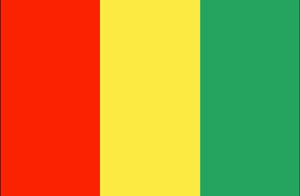Current travel advisories for Guinea
Hinweis: der Gesamtscore für dieses Land gibt aktuell einen falschen Wert aus. Bitte prüft die Quellen.
Note: the total score for this country shows a wrong value. Please check the sources.
Last Update: Tuesday, 13. August 2024 at 08:21
 Please reconsider your need to travel to Guinea.
Please reconsider your need to travel to Guinea.
Anzeige
Current situation : 4 / 5
Guinea is a country in Africa (Western Africa) with around 11 million citizens and a land mass of 245,857 km². We detected travel advisories from 4 sources for this country.
Bordering countries: 3.6 / 5
Guinea shares land borders with 6 neighbouring states. For this country, the Danger Index is 3.6 (average value for all countries). All countries habe been reported as somehow dangerous: Mali (4.6), Senegal (3.6), Liberia (3.5), Sierra Leone (3.5), Ivory Coast with (3.3) and Guinea-Bissau with (3.0 of 5). See danger map of the region.
Current informationen on Covid-19
The European Centre for Disease Prevention and Control currently reports of no cases of COVID-19 (infection with SARS-CoV-2 or Coronavirus).
Source: www.ecdc.europa.eu
Single advisories / travel warnings
Danger level: 2
Exercise increased caution / Some Risk.
Reisewarnstufe: 0
.
Reisewarnstufe: 4
Avoid non-essential travel / High Risk.
Danger level: 3
Exercise a high degree of caution.
Danger level: 4
.
If there is more than one advisory/message of a single government for a given country, it indicates regional differences in means of security for your personal health and well-being. Single messages can indicate specific regions to be safer or less safe as mentioned in the main advisory. In these cases it's advisable to consult your own governments information. Additional Disclaimer: Since the evaluation is an automated process, it can only provide first steps for your own research. Please make sure to consult the sources.
Advertising
Country information
Country flag

Basic facts
- Citizens
- around 11 million
- Covering landmass
- 245,857 km²
- Electricity
- 220V - 50Hz
- Currency
- Franc (GNF)
- ISO 2-Letter Code
- GN
- Phone prefix
- +224
- Top Level Domain
- .gn
- Mobile frequencies (MHz)
- 900
Airports in Guinea (extern)
Video
Frequently asked questions
This section gives some brief answers to common questions regarding travel safety in Guinea.
Is Guinea safe to travel in 2020?
There are some travel advisories for Guinea. With a risk index of 4 out of 5 possible point, we suggest you consult your local authorities before booking a flight.
How many countries have issued advisories for Guinea?
We currently know of 4 countries having issued advisories for Guinea.
What countries does Guinea share land borders with?
Guinea shares land borders with 6 neighbouring states. For this country, the Danger Index is 3.6 (average value for all countries). All countries habe been reported as somehow dangerous: Mali (4.6), Senegal (3.6), Liberia (3.5), Sierra Leone (3.5), Ivory Coast with (3.3) and Guinea-Bissau with (3.0 of 5). See danger map of the region.
 New Zealand government
New Zealand government Canadian government
Canadian government US American government
US American government